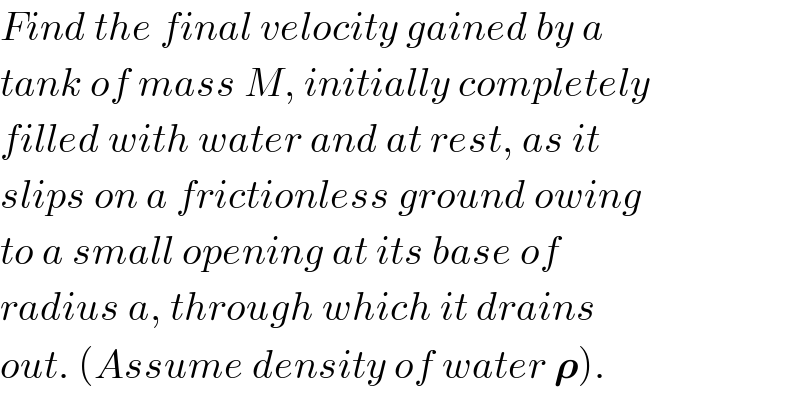
Question and Answers Forum
Question Number 29687 by ajfour last updated on 11/Feb/18

Commented by ajfour last updated on 11/Feb/18

Commented by 803jaideep@gmail.com last updated on 11/Feb/18

Commented by ajfour last updated on 11/Feb/18

Commented by ajfour last updated on 11/Feb/18

Answered by mrW2 last updated on 12/Feb/18
![M_W =mass of water at begin=πR^2 hρ at water depth y: total mass: m=M+M_W (y/h) ⇒(dm/dt)=(M_W /h)×(dy/dt) (relative) speed of outgoing water: v=(√(2gy)) let′s say speed of tank=u −v(dm/dt)=m(du/dt) −v×(M_W /h)×(dy/dt)=m(du/dy)×(dy/dt) −(M_W /h)v=m(du/dy) −(M_W /h)(√(2gy))=(M+(M_W /h)y)(du/dy) −(M_W /h)×((√(2gy))/(M+(M_W /h)y)) dy=du −(√(2g))×((√y)/((((hM)/M_W )+y))) dy=du with k=((hM)/M_W ) −(√(2g))×∫_h ^( 0) ((√y)/((k+y))) dy=∫_0 ^( u_(max) ) du (√(2g))×2(√k)[(√(y/k))−tan^(−1) (√(y/k))]_0 ^h =u_(max) u_(max) =2(√(2gk))((√(h/k))−tan^(−1) (√(h/k))) u_(max) =2(√((2ghM)/M_W ))((√(M_W /M))−tan^(−1) (√(M_W /M))) with λ=(M_W /M) ⇒u_(max) =2(√((2gh)/λ))((√λ)−tan^(−1) (√λ)) Example: λ=(M_W /M)=5, h=1 m ⇒u_(max) =2(√((20)/5))((√5)−tan^(−1) (√5))=4.3 m/s ==================== u(y)=2(√(2gk))((√(h/k))−(√(y/k))−tan^(−1) (√(h/k))+tan^(−1) (√(y/k))) πa^2 vdt=−πR^2 dy ⇒(dy/dt)=−(a^2 /R^2 )v=−((a^2 (√(2gy)))/R^2 ) ⇒(dy/(√y))=−((a^2 (√(2g)))/R^2 ) dt ⇒∫_h ^( y) (dy/(√y))=−((a^2 (√(2g)))/R^2 ) ∫_0 ^( t) dt ⇒2((√y)−(√h))=−((a^2 (√(2g)))/R^2 )×t ⇒(√y)=(√h)−((a^2 (√(2g)))/(2R^2 ))×t=(√h)−pt ⇒y=h−2(√h)pt+p^2 t^2 y=0⇒t=((√h)/p)=(R^2 /a^2 )(√((2h)/g))=t_1 (at t_1 tank is empty) ⇒u(t)=2(√(2gk))[((pt)/(√k))−tan^(−1) (√(h/k))+tan^(−1) ((√(h/k))−((pt)/(√k)))] with η=(p/(√k))=(a^2 /R^2 )(√((2gλ)/h)) ⇒u(t)=2(√((2gh)/λ))[ηt−tan^(−1) (√λ)+tan^(−1) ((√λ)−ηt)]](Q29759.png)
Commented by mrW2 last updated on 12/Feb/18
Is any solution for this question given?
Commented by ajfour last updated on 12/Feb/18

Commented by ajfour last updated on 12/Feb/18

